At the beginning of the nineteenth century, Alexanderplatz was one of the busiest squares in Berlin. Its current appearance is mostly the result of the efforts of the former government of East-Germany to use the square as a showpiece of Socialist architecture.
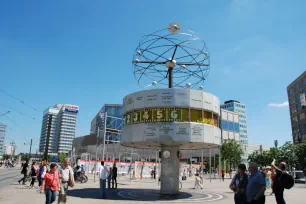
Despite recent attempts to make the square more attractive, Alexanderplatz is still a concrete island enclosed by large buildings and can come across as rather soulless.
Chances are however that you’ll end up here at some point during your stay in Berlin, since it’s an important traffic and shopping hub. And the TV-tower on the southern edge is visible from almost anywhere in Berlin.
History
Ox Market
During the Middle Ages, when the square was at the heart of a network of narrow passageways and streets, it was called the Ochsenmarkt or ox market. In 1805, after a visit by Russian Tsar Alexander I the square was renamed Alexanderplatz. The locals simply call this large square ‘Alex’.
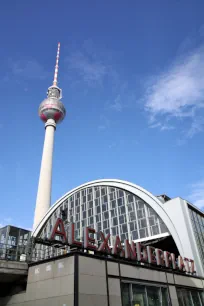
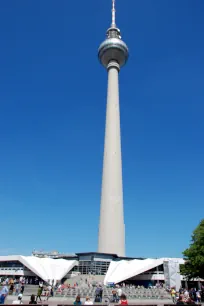
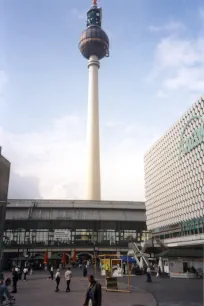
At the time, ten streets converged here. The square gained even more importance as a transportation hub in 1882 when a railway station opened in the middle of the square. It was followed in 1913 by a subway station. In the eighteenth century Alexanderplatz was embellished with a majestic colonnade, the Königskolonnaden. Unfortunately, due to the ever-increasing traffic, the monument was moved in 1910 to Kleistpark.
Socialist Architecture
Most of the buildings on the square were destroyed by allied bombing during the Second World War. After the war, Alexanderplatz became the de facto center of East-Berlin. The square was enlarged and used as a showcase of Socialist architecture. This resulted in some plain, ‘shoebox-ugly’ buildings and a huge television tower, which was the pride of the East German government.
Two buildings from the late 1920s survived the destruction of the war and the postwar redevelopments: the Berlina-Haus and the Alexanderhaus. Both buildings were designed by Peter Behrens in a functional style that was called ‘Neue Sachlichkeit’ (New Objectivity).
Ambitious Plans…
The square was known to be one of the least attractive from an architectural point of view, so shortly after the reunification the city of Berlin commissioned an architectural competition, which was won by Hans Kohlhoff (also one of the architects of the modern Potsdamer Platz). Kohlhoff created an ambitious plan that would completely transform the area with the construction of ten towers, each about 150 meters (500 ft) tall.
…were toned down
Ten years later, however, none of these plans had been implemented. Instead, a more modest plan was designed by the architectural firm of Gerkan, Marg and Partners in collaboration with WES-Landschaftsarchitekten, a company specialized in architectural landscaping.
The plan resulted in a complete redevelopment of the square, as well as the renovation of surrounding buildings. The World Time Clock and the fountain were also renovated.
Sights
TV-tower
The TV tower, known as the Fernsehturm or the Tele-spargel is one of the tallest structures in Europe. The total height to the top of the spire is 365 meters, or 1197 feet. It was built in 1969 by a team of architects with the help of Swedish experts. It consists of a concrete shaft, a steel-clad metal sphere and a TV antenna. The sphere contains a revolving restaurant (Telecafé) at 207 meters and a viewing platform at a height of 203 meters (666 ft).
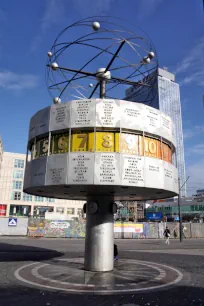
World Clock
In 1969 two more monuments were added to the square: the Weltzeituhr (World Time Clock) and the Brunnen der Völkerfreundschaft (Fountain of International Friendship).
The world clock was designed by the industrial designer Erich John. It consists of a column planted in the center of a wind rose. On top of the column rests a twenty-four-sided cylinder. Each side represents a time zone and shows the names of a number of foreign cities in that particular time zone. On top of the clock is a simplified model of the solar system.
In 1997, when the clock was restored, a number of cities that were originally left out for political reasons were added, namely Jerusalem, St. Petersburg and Cape Town. The clock was, and still is, one of Berlin’s most popular rendezvous points.
Fountain of International Friendship
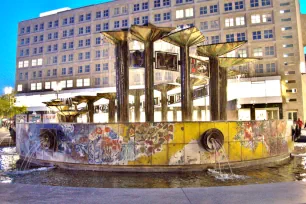
The Fountain of International Friendship is also a remnant of the GDR-era. The circular fountain measures about 23 meters wide and is over six meters tall. At the center of the fountain is a modern structure that consists of a series of basins. Water flows from one basin to another, forming a small cascade. The fountain – a protected monument – was renovated in 2002.

